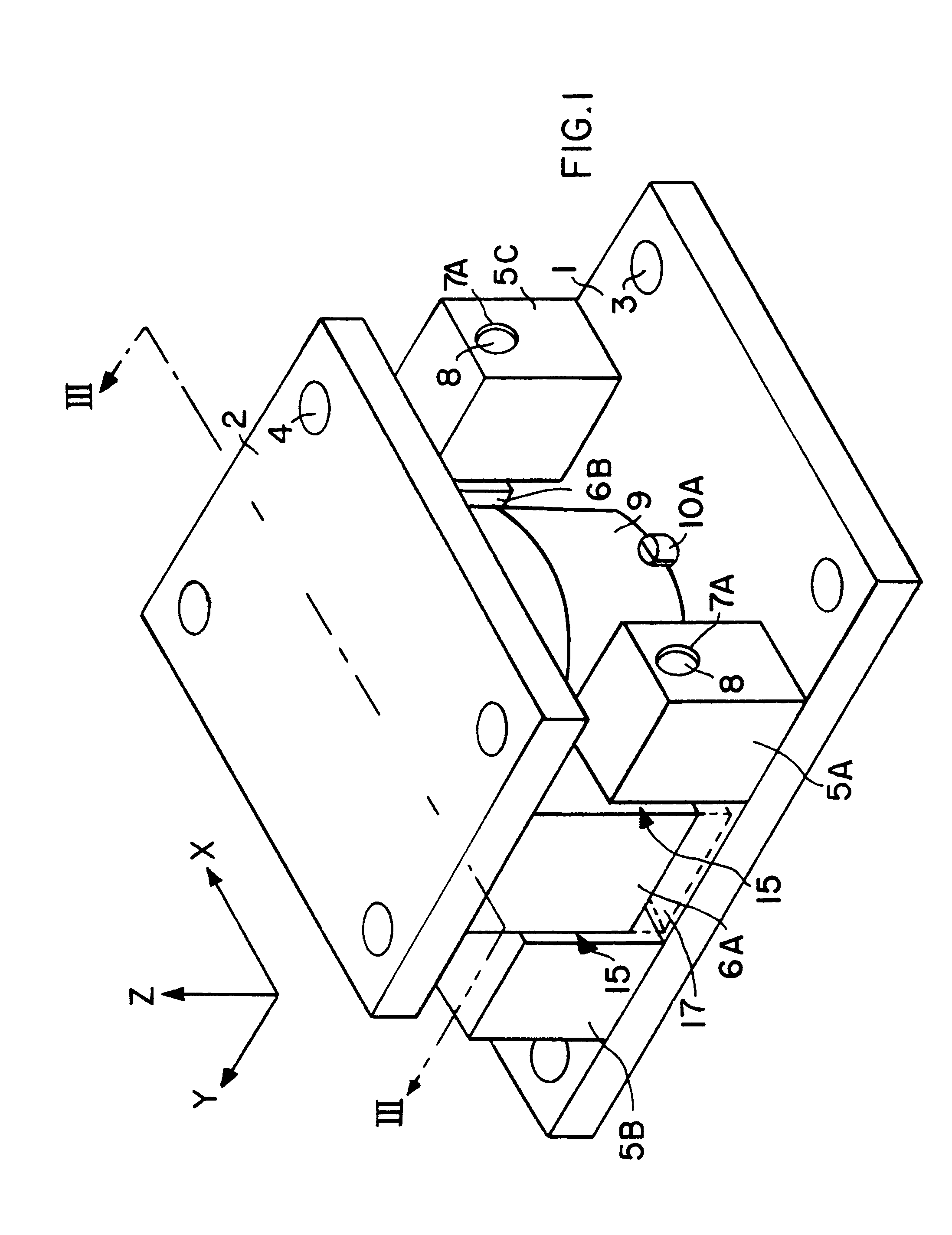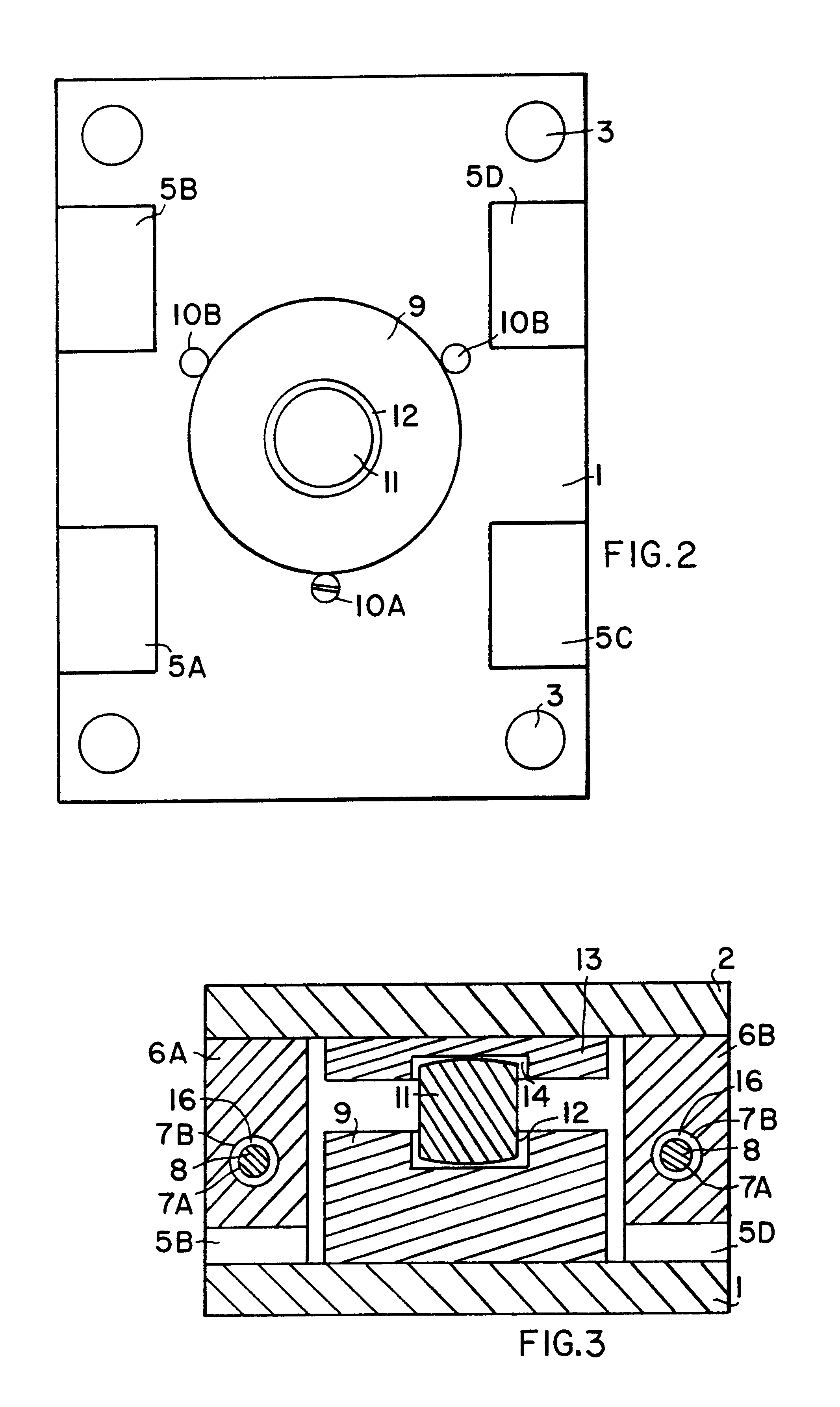Tank weigh module with excess motion restraint
a technology of a weigh module and a motion restraint, which is applied in the direction of weighing apparatus details, weighing relieving/arresting mechanisms, instruments, etc., can solve the problems of excessive downward travel of the weigh module, excessive uplift travel, and the possibility of tilting or twisting motion of the weigh modul
- Summary
- Abstract
- Description
- Claims
- Application Information
AI Technical Summary
Benefits of technology
Problems solved by technology
Method used
Image
Examples
first embodiment
With reference to FIGS. 1, 2 and 3, a tank weigh module according to the invention includes a bottom plate 1 and a top plate 2 positioned substantially parallel to each other and spaced apart from each other, and adapted to receive a load cell 9 between the two plates 1 and 2. The bottom plate 1 has mounting holes 3 by which the plate 1 may be bolted to a supporting floor or the like. The top plate 2 has mounting holes 4 by which the plate 2 may be bolted to a supporting leg of a tank or other vessel, or any other item that is to be weighed. Typically, three or four of the present tank weigh modules will respectively be arranged and secured under the three or four legs of a tank or other vessel.
In order to provide the inventive free-floating, yet restrained connection between the top plate 2 and the bottom plate 1, the present embodiment comprises four lower stop blocks 5A, 5B, 5C and 5D connected (preferably welded) to the bottom plate 1 so as to protrude upwardly from the bottom p...
second embodiment
The distal or right-hand edge of the top plate 2 as shown in FIG. 4 is not connected to the bottom plate 1. Instead, the top plate 2 remains freely tiltable relative to the bottom plate 1, about the axis of the restraining pin 8, which acts as a hinge. Nonetheless, the present embodiment of the weigh module provides the desired range of free play motion, while preventing or restraining excessive motion in the back-and-forth Y-direction, the side-to-side X-direction, and the uplift Z-direction, as well as tilting about the X-axis and twisting about the Z-axis. A restraint against excess tilting about the Y-axis, i.e. about the axis of the restraining pin 8, is achieved by the cooperative arrangement of at least two of these weigh modules connected to the tank or other vessel being weighed. As long as the other weigh modules are not oriented in exactly the same orientation as the first weigh module, then a restraint of the tank in all possible motion and tilting directions will be ach...
third embodiment
Referring now to FIG. 5, the present weigh module comprises two lower stop blocks 5A and 5C connected to the bottom plate, two upper stop blocks 6A and 6B connected to the top plate 2, and two restraining pins 8, which are particularly embodied as restraining bolts 8'. In this embodiment, the restraining bolts 8' provide not only the restraining function in the positive and negative X-direction and the positive and negative Z-direction, but also in the positive Y-direction. Namely, when the top plate 2 moves in the negative Y-direction relative to the bottom plate 1, the upper stop blocks 6A and 6B will come to bear against the lower stop blocks 5A and 5C. However, since there are no lower stop blocks on the opposite sides of the upper stop blocks 6A and 6B, the restraining bolts 8' must somehow restrain the upper stop blocks 6A and 6B from excessive motion in the positive Y-direction.
This can be achieved in various ways. As shown on the left side of the weigh module in FIG. 5, the ...
PUM
 Login to View More
Login to View More Abstract
Description
Claims
Application Information
 Login to View More
Login to View More - R&D
- Intellectual Property
- Life Sciences
- Materials
- Tech Scout
- Unparalleled Data Quality
- Higher Quality Content
- 60% Fewer Hallucinations
Browse by: Latest US Patents, China's latest patents, Technical Efficacy Thesaurus, Application Domain, Technology Topic, Popular Technical Reports.
© 2025 PatSnap. All rights reserved.Legal|Privacy policy|Modern Slavery Act Transparency Statement|Sitemap|About US| Contact US: help@patsnap.com



